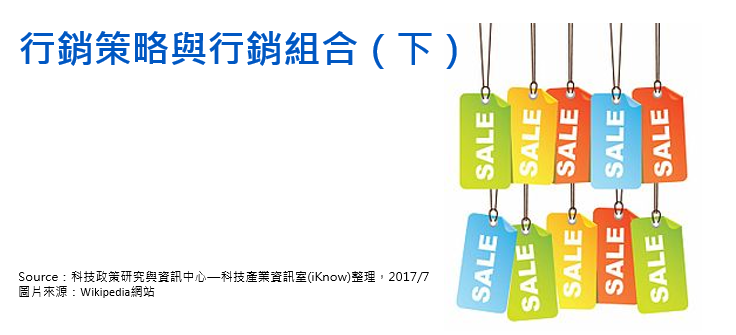
圖、行銷策略與行銷組合(下)
價格( price )與定價( pricing )與行銷 4P 中重要環節之一,定價太低利潤變差,定價太高市場競爭力降低,如何訂定一個好的價格,或是建立一個優質定價策略為一重要議題。
根據 Wilipedia 說明,定價( pricing )為:
Pricing is one of the four p's of the marketing mix. The other three aspects are product management, promotion, and place. It is also a key variable in microeconomic price allocation theory.
Pricing is the manual or automatic process of applying prices to purchase and sales orders , based on factors such as: a fixed amount, quantity break, promotion or sales campaign, specific vendor quote, price prevailing on entry, shipment or invoice date, combination of multiple orders or lines, and many others. Automated systems require more setup and maintenance but may prevent pricing errors .
決定價格方法包括:
How to set the price?: ( cost-plus pricing , demand based or value-based pricing , rate of return pricing, or competitor indexing )
亦即定價法可約略分為成本法、價值法與競爭者比較法等三種。此外,在前述張忠謀的文章中也提到成本法與價值法的概念,包括:
此外 Marketing 人員也要決定市場需要什麼產品或新技術,還要為產品訂定策略性價格( Strategic Pricing ),有人認為只要在成本上加一些百分比就是訂價了,這是成本導向、很平庸的成本訂價( Cost-based Price )。
好的訂價法是價值導向的訂價( Value-Based Price ) ,例如英特爾的 Pentium 處理器,價格的獲利率在 70% 以上,一般訂價的獲利率只有 40% ,英特爾的處理器就是價值導向訂價,晶圓代工的價格也是例子。
根據參考資料 [1] 與黃俊英教授的書籍說明,成本法即是根據產品成本所進行的加成( markup )定價,亦稱為加成定價法( markup pricing ) [2] ;價值法是根據需求端或是產品的價值所設定的價格,也可稱為超值定價法( value pricing )或是需求導向定價法( demand-based pricing );競爭者比較法即是以市場上其他提供相似產品的競爭者定價為參考資料所擬訂的價格( competitor indexing pricing )。在此三項方法中,價值法所能得的利潤最高,當然所需要的產品競爭力也要較高(通常為寡占),成本法或是競爭者利潤較差,原因無他,相關產品所處多為競爭激烈市場。
最後需要注意,定價為產品行銷的一環節,因此定價之高低與其他行銷 3P 或是 7P 息息相關,包括產品( product )、通路( place )與促銷( promotion )等。此外,如站在更高角度論,定價與整體企業比較競爭優勢或是大環境亦息息相關,換言之,行銷規劃中之環境分析、行銷策略規劃與行銷組合均會影響最終價格。當然,最終成交價格亦與付款條件( payment )息息相關 [3][4] ,畢竟付現金與付三個月到期支票的價格是不會相同的。 (1002字)
參考資料:
--------------------------------------------------------------------------------------------------------------------------------------------